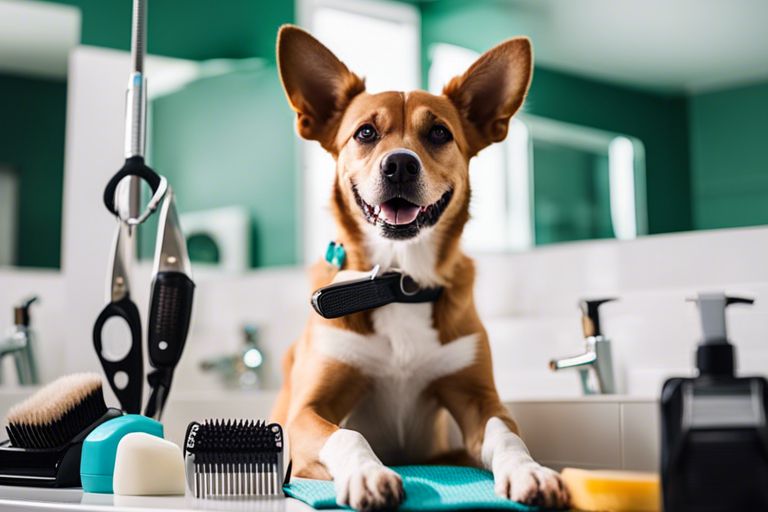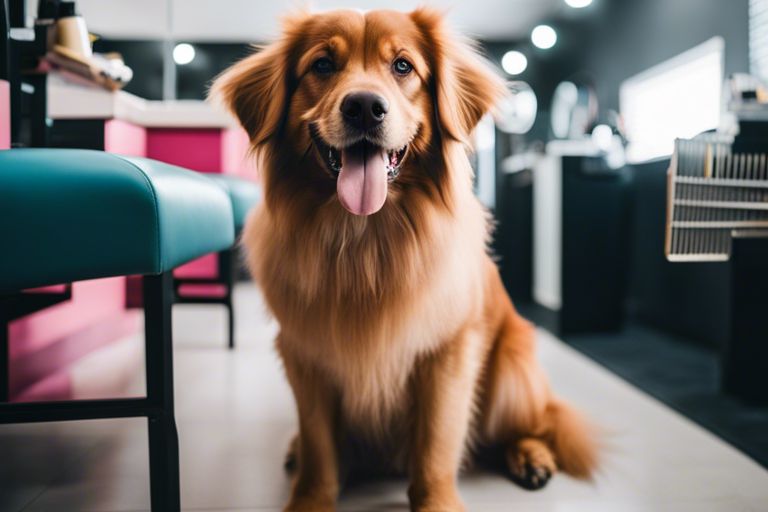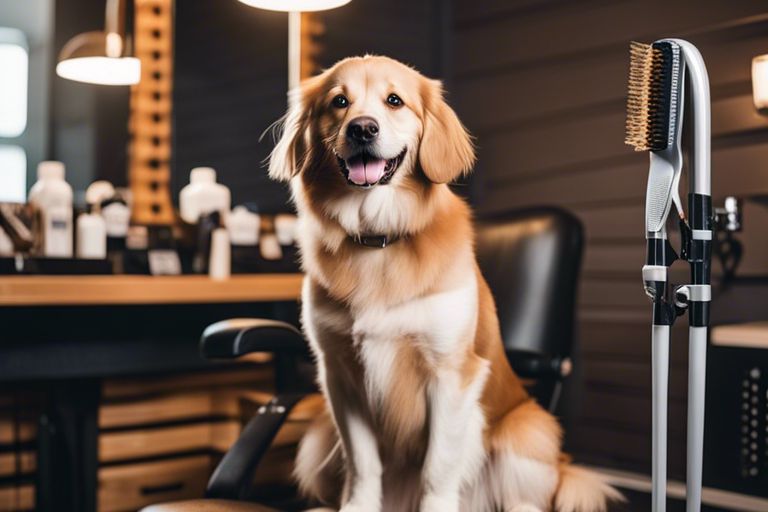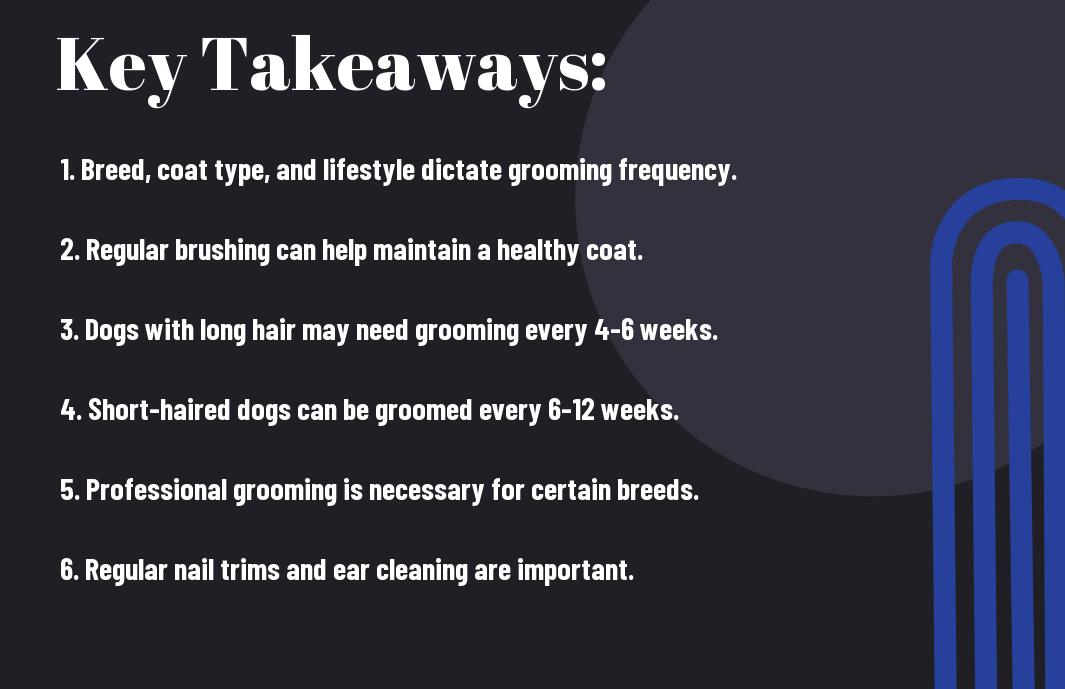You know how dogs can go from being fluffy clouds of perfection to mud-clad mischief makers in a matter of seconds. So, the big question remains – how often should you be dragging your furry friend to the groomers? Let’s examine this hairy situation and figure out the paw-fect grooming schedule to keep your four-legged buddy looking fabulously fresh!
Key Takeaways:
- Regular grooming is important: Dogs should be groomed regularly to maintain their overall health and appearance. Frequency can vary depending on the breed and coat type of the dog.
- Brushing is crucial: Daily brushing is recommended for most dogs to prevent matting and keep their coat clean and healthy. This also helps distribute natural oils and remove loose fur.
- Professional grooming may be needed: Some dogs require regular trips to a professional groomer for services such as haircuts, nail trimming, and ear cleaning. It’s important to follow recommendations based on your dog’s specific needs.
“Maintaining a dog’s grooming routine is like maintaining a friendship – it requires regular attention and care. Just like how a good book needs bookmarking, a dog needs regular grooming to stay in top shape. Treat your furry friend with the love and care they deserve!”
The Importance of Grooming
Why Grooming is Essential for a Dog’s Health
The grooming routine of a dog is not just about maintaining their appearance; it plays a crucial role in their overall well-being. Regular grooming helps in keeping their skin and coat healthy by preventing mats, parasites, and skin irritations. It also allows for early detection of any lumps, bumps, or injuries that may otherwise go unnoticed.
The Consequences of Neglecting Grooming
Essential grooming is not just a matter of aesthetics; it directly impacts a dog’s health and comfort. Neglecting grooming can lead to a variety of issues such as mats that pull on the skin, overgrown nails causing difficulty in walking, ear infections from trapped moisture, and skin infections from dirt accumulation.
Plus, grooming sessions are not only beneficial for the dog’s physical health but also provide an excellent opportunity for bonding between the pet and its owner. It is a time for mutual trust-building and relaxation, enhancing the emotional well-being of both parties.
Factors Affecting Grooming Frequency
It’s imperative to consider various factors when determining how often your dog should be groomed. Factors such as breed, coat type, age, health status, lifestyle, and environment all play a role in determining the grooming frequency that is best for your furry friend.
Breed and Coat Type
For some breeds with longer or denser coats, more frequent grooming is necessary to prevent mats, tangles, and skin issues. Breeds such as Poodles, Shih Tzus, and Siberian Huskies typically require more regular grooming to maintain the health and appearance of their coats.
After considering your dog’s breed and coat type, you can determine a grooming schedule that includes brushing, bathing, trimming, and other necessary grooming tasks to keep their coat in top condition.
Age and Health Status
With age and health status, grooming frequency may need to be adjusted. Puppies may need more frequent grooming to get them used to the process and maintain their developing coats. Older dogs or those with health issues may require special grooming attention to address specific needs such as sensitive skin or mobility issues.
Coat maintenance is vital in helping to identify any changes in your dog’s skin or coat that may indicate underlying health concerns. Regular grooming sessions can help you detect and address any issues early on.
Lifestyle and Environment
Affecting the grooming frequency, your dog’s lifestyle and environment can play a significant role. Dogs that spend a lot of time outdoors or are more active may need more frequent grooming to remove dirt, debris, and pests from their coat. Similarly, dogs living in a humid climate may require more frequent baths to prevent skin issues.
Type of activities your dog engages in, such as swimming or rolling in the mud, can also affect how often they should be groomed. Adjusting the grooming schedule based on your dog’s lifestyle and environment can help keep their coat healthy and free of any unwanted hitchhikers.
Grooming Needs by Breed
Short-Haired Breeds
Many short-haired dog breeds, such as Beagles and Dalmatians, have low grooming needs compared to their long-haired counterparts. A weekly brush with a soft bristle brush can help keep their coat looking sleek and shiny. Bathing can be done on an as-needed basis, such as when they start to smell or get dirty from outdoor adventures.
Long-Haired Breeds
An example of long-haired breeds includes Afghan Hounds and Maltese dogs. These breeds require more frequent grooming to prevent matting and tangles in their luxurious coats. Daily brushing is recommended to keep their fur free of debris and prevent it from becoming tangled. Regular baths with a dog-specific shampoo can also help maintain their coat’s health and appearance.
To ensure the coat stays in top condition, professional grooming sessions every 4-6 weeks are recommended for long-haired breeds. This will help keep their coat healthy, prevent matting, and reduce the risk of skin issues due to trapped dirt and debris.
Curly-Coated Breeds
Grooming curly-coated breeds, such as Poodles and Bichon Frises, can be a bit more intensive due to their unique coat texture. Regular brushing with a slicker brush to prevent matting and remove loose fur is necessary. These breeds may also require regular trims to maintain a tidy and manageable coat length.
For curly-coated breeds, it’s crucial to establish a grooming routine early on to get them used to the process. This can help make grooming sessions more manageable for both the dog and the owner, ensuring the dog’s coat stays healthy and tangle-free.
Grooming Techniques and Tools
Brushing and Combing
Grooming your dog regularly is important for their health and wellbeing. Not only does it keep their coat looking shiny and clean, but it also helps prevent mats and tangles from forming. Brushing and combing are key components of a good grooming routine. It is recommended to brush your dog at least a few times a week, depending on their breed and coat type. Long-haired dogs may require daily brushing to prevent matting, while short-haired breeds can usually get by with less frequent grooming sessions.
Bathing and Shampooing
Combing through your dog’s coat before giving them a bath can help remove any loose fur and detangle any knots. When bathing your dog, it’s important to use a dog-specific shampoo to avoid stripping their coat of natural oils. Dog breeds with oily coats may need more frequent baths, while others can go longer between washes to prevent skin dryness.
Remember to thoroughly rinse out all the shampoo to prevent skin irritation. After bathing, be sure to dry your dog completely to avoid any skin issues that can arise from moisture being trapped in their coat.
Trimming and Clipping
Grooming your dog may also involve trimming or clipping their coat, especially if they have long hair that grows quickly. Some breeds, such as poodles or shih tzus, may need regular haircuts to maintain a neat appearance and prevent matting. It’s important to use sharp scissors or clippers designed for pet grooming to avoid accidents and ensure a clean cut.
When trimming your dog’s coat, take your time and be patient. It’s better to trim small amounts at a time to avoid cutting too much hair and potentially causing discomfort to your furry friend. If you’re unsure about how to trim your dog’s coat, consider consulting a professional groomer for guidance.
To keep your dog looking and feeling their best, make sure to establish a grooming routine that includes brushing, combing, bathing, and trimming as needed. Regular grooming not only keeps your dog’s coat healthy but also strengthens the bond between you and your beloved pet.
Creating a Grooming Schedule
To ensure that your dog always looks and feels their best, it’s vital to establish a grooming schedule that fits their needs. By staying organized and consistent, you can keep your furry friend feeling fresh and healthy all year round.
Daily and Weekly Tasks
Daily grooming tasks for your dog may include brushing their coat to prevent matting and removing any debris or dirt. Additionally, checking their ears and paws for any signs of irritation or infection is crucial for their health.
Monthly and Quarterly Tasks
With monthly tasks, consider giving your dog a bath to keep their coat clean and shiny, as well as trimming their nails to a safe length. Quarterly tasks could involve a more thorough grooming session, such as a full haircut or a visit to a professional groomer for a trim.
Grooming your dog regularly not only keeps them looking good but also contributes to their overall well-being. It allows you to spot any skin issues, lumps, or bumps that may need veterinary attention early on.
Seasonal Considerations
Seasonal grooming considerations may include adjusting your dog’s grooming routine based on the weather. In the winter, you may need to bathe them less frequently to prevent dry skin, while in the summer, more frequent baths may be necessary to keep them cool and clean.
Another important aspect of seasonal grooming is adjusting the length of your dog’s coat. Longer coats may need to be trimmed shorter in the summer to help them stay cool, while leaving it longer in the winter can provide extra insulation against the cold.
Common Grooming Challenges
Matting and Tangling
All dog owners face the challenge of dealing with matting and tangling in their furry friends’ coats. Any dog with long or curly hair is prone to these issues, which can be painful and uncomfortable for the pup. Regular grooming is crucial to prevent mats from forming, as they can lead to skin irritation and even infection.
Shedding and Hair Loss
Loss of hair is another common grooming challenge that dog owners encounter. Shedding is a natural process for dogs, but excessive hair loss can be a sign of an underlying issue such as poor nutrition or stress. It’s crucial to brush your dog regularly to help reduce shedding and keep their coat healthy and shiny.
This type of grooming challenge can be managed with the right tools and techniques. Regular brushing, a balanced diet, and stress management techniques can help reduce excessive shedding and promote a healthy coat for your furry friend.
Skin Irritations and Allergies
Loss of skin irritations and allergies are common grooming challenges that many dog owners face. Skin allergies can be triggered by various factors such as food, environmental allergens, or grooming products. It’s crucial to observe any signs of skin irritation such as redness, itching, or inflammation and consult a veterinarian if needed.
Challenges related to skin irritations and allergies can be managed by using hypoallergenic grooming products, maintaining a clean living environment, and identifying and avoiding triggers that may cause allergic reactions in your dog.
To wrap up
Drawing together the information presented, it is clear that the frequency of grooming for a dog ultimately depends on various factors such as their breed, coat type, and lifestyle. Regular grooming is crucial not just for your dog’s physical appearance but also for their overall health and wellbeing. Consulting with a professional groomer can help determine a grooming schedule that is tailored to your dog’s specific needs.
Remember to also incorporate grooming into your routine at home to maintain your dog’s hygiene and ensure they are comfortable and happy. By staying on top of grooming, you can prevent potential health issues and keep your furry friend looking and feeling their best. So, whether it’s a weekly brushing session or monthly salon visit, keeping your dog clean and well-groomed is a key part of being a responsible pet owner.
FAQ
Q: How often should a dog be groomed?
A: Dogs should be groomed regularly, depending on their breed and coat type. Generally, a good rule of thumb is to groom your dog every 4-6 weeks to keep their coat healthy and free of mats.
Q: What are the benefits of regular grooming for dogs?
A: Regular grooming has numerous benefits for dogs, including maintaining a healthy coat, reducing shedding, preventing matting, promoting good hygiene, and spotting any health issues early on.
Q: What does a typical dog grooming session involve?
A: A typical dog grooming session involves brushing and combing the coat, trimming the nails, cleaning the ears, brushing the teeth, and bathing the dog. Some breeds may also require haircuts or specific grooming techniques.
Q: How can I tell if my dog needs grooming?
A: Signs that your dog may need grooming include a tangled or matted coat, a strong odor, overgrown nails, dirty ears, or skin irritation. Regularly checking your dog’s coat and overall appearance can help you determine when grooming is necessary.
Q: Can I groom my dog at home or should I take them to a professional groomer?
A: While some basic grooming tasks can be done at home, such as brushing and combing, more complex grooming procedures like haircuts or nail trimming are best left to professional groomers. They have the experience and tools needed to groom your dog safely and effectively.




